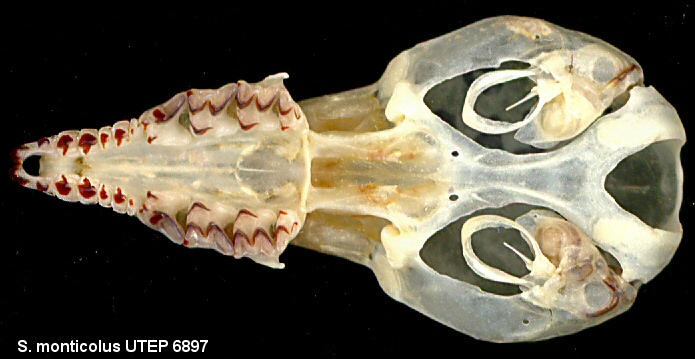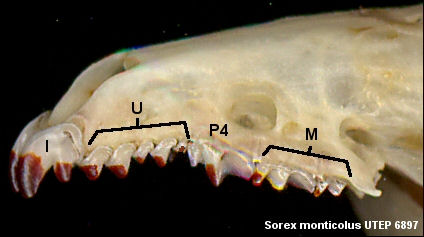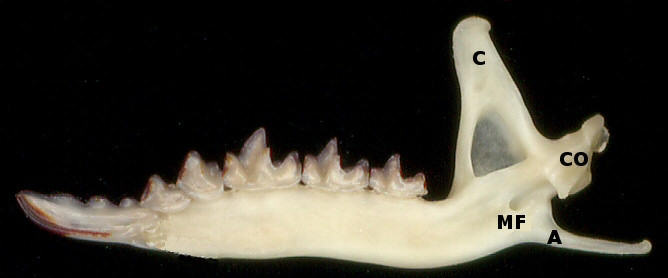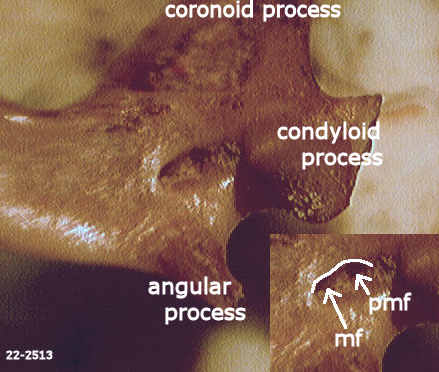The hedgehogs were earlier considered members of the order Insectivora. With the breaking up of the Insectivora, they now are placed in an order of their own. Although known from the New World as fossils, hedgehogs now are limited to Africa, Eurasia, and parts of Indonesia, the Philippines, and vicinity. The name "hedgehog" sometimes is applied to the North American Porcupine Erethizon dorsata in the U.S., but only because of the superficial similarity to the European hedgehog (both possess quills).
The shrews and moles, along with the Erinaceomorpha and some other groups, formerly were placed in the Insectivora (which no longer is generally recognized as a taxonomic order). For pictures of soricomorphs and further information, see the Animal Diversity Web.
Members of this family likely are all extinct. They were distributed on islands in the West Indies and probably became extinct with colonization of the islands by humans. Remains are mostly sub-fossil, though a late Oligocene/early Miocene fossil suggestive of a nesophontes is known from Dominican amber.
The taxonomic position of the Solenodontidae is uncertain, but placed tentatively in the Soricomorpha. Two living species are known, one in Cuba and one in Haiti and the Dominican Republic. Both species are endangered. Two extinct species of solenodons from the same areas are known from apparently Pleistocene and Holocene deposits.
The living shrews comprise about 20 genera and some 200 species. They are widespread geographically, though absent from Australia and all but the most northern parts of South America. In the New World, they are predominantly northern animals, coming far south in mesic habitats; however, a few species have adapted to semi-arid conditions both in the Old World and in the New World. Most are small, and one species vies for the record of smallest living mammal (the Etruscan Shrew with a weight of about 2 g). Head/body length varies from about 35 mm to 180 mm. Because of the small size and concomitant problems retaining heat, they have a high metabolic rate requiring frequent meals and high-energy foods. All apparently are primarily carnivorous (mostly insectivorous, but other animal food is taken by various species in addition to invertebrates), but some species take plant material rich in calories, such as seeds and the meat of nuts.
 Shrews lack auditory bullae and zygomatic
arches. Although eyesight is poor, the senses of hearing and olfaction are well developed, and apparently sonar (echo-location) is utilized by at least some. These are extremely active animals and
usually move within the ground litter or in burrows or runways constructed by themselves or by other small animals.
Shrews lack auditory bullae and zygomatic
arches. Although eyesight is poor, the senses of hearing and olfaction are well developed, and apparently sonar (echo-location) is utilized by at least some. These are extremely active animals and
usually move within the ground litter or in burrows or runways constructed by themselves or by other small animals.
Fig. 1 (right). This ventral view of the skull of Sorex monticolus (Montane Shrew) shows the absence of zygomatic arches and auditory bullae and also shows the typical annular rings supporting the tympanum. The pigmented areas of the teeth also can be seen.
Shrews are known for their ferociousness, and some may subdue cornered prey as large as themselves. At least some taxa are known to possess poisonous saliva that quickly subdues most prey, and there are accounts of humans being bitten with subsequent pain or numbness. Coprophagy (re-ingesting feces) is known for some species, possibly to obtain vitamins manufactured in the gut by bacteria.
Fig. 2 (below) shows the rostral area of a Montane Shrew. The protruding incisor looks almost like two incisors because of its basal cusp. Five unicuspids are labeled, as is P4 and the molars. The pigmented nature of the teeth shows clearly. The absence of a zygomatic arch also can be seen.
 The deciduous teeth are shed in
utero, so that the teeth appearing at or after birth form the permanent dentition. The front incisors, upper and lower, are enlarged and project forward, forming pincers; teeth behind these
incisors and anterior to the fourth premolar have only one prominent cusp (and thus are "unicuspids"). Upper molars have the occlusal surface marked by a "W"-shaped ridge (dilambdodont). North
America forms have a reddish-brown pigment tipping the teeth, although much reduced in the Desert Shrew, Notiosorex crawfordi. One suggestion has been that it makes the teeth less
attention-grabbing to prey.
The deciduous teeth are shed in
utero, so that the teeth appearing at or after birth form the permanent dentition. The front incisors, upper and lower, are enlarged and project forward, forming pincers; teeth behind these
incisors and anterior to the fourth premolar have only one prominent cusp (and thus are "unicuspids"). Upper molars have the occlusal surface marked by a "W"-shaped ridge (dilambdodont). North
America forms have a reddish-brown pigment tipping the teeth, although much reduced in the Desert Shrew, Notiosorex crawfordi. One suggestion has been that it makes the teeth less
attention-grabbing to prey.
In the temperate regions, breeding is during the warmer months, with gestation periods apparently around 12 to 28 days, depending on species. The young are altricial and are weaned about 2 to 4 weeks after birth. Most probably expire before the middle of their second year in the wild. In at least some, the cranium may change shape with age, possibly by season.

Fig. 3. Lingual view of the right dentary of a shrew (Sorex) with several labeled parts. C = Coronoid Process. CO = Condyloid Process. A = Angular Process. MF = Mandibular Foramen. Note the anteriorly oriented incisor, two unicuspid teeth, and three molars.
Three genera and nine species are known from our region. Members of the genus Sorex are mostly montane forms in the region, although Sorex merriami extends into brushy or heavily grassed areas below woodland in the central or northern part of New Mexico. The Least Shrew (Cryptotis parva) is limited to the northeastern part of New Mexico in our region, mostly in marshy situations. The Desert Shrew generally inhabits lowlands in the state (though it has been taken as high as lower Ponderosa Pine forest), usually in situations where the microhabitat provides humidity—thus moist areas along the Rio Grande and rock slides may be inhabited.
The three regional genera of shrews can be told apart on the skull by the number of upper unicuspids (the number of teeth between the first incisor and premolar 4). These number five in Sorex, four in Cryptotis (be careful—the fourth unicuspid is minute), and three in Notiosorex (see the soricomorph key).
Sorex arizonae and S. merriami are related forms characterized by, among other things, the possession of a postmandibular foramen on the posterior,
lingual portion of the dentary (the other species considered here have only a mandibular foramen). The Arizona Shrew has an extra tine on the upper incisor not present in Merriam's Shrew.
Fig. 4 (left). Posterior lingual view (with ventral margin elevated) of the right dentary of Sorex merriami with processes and mandibular and post-mandibular foramena labeled. Specimen is a Pleistocene fossil (UTEP 22-2513) from southeastern New Mexico.
Sorex arizonae is relatively recently discovered and, in our region, is known only from the Animas Mountains of the bootheel of New Mexico. Sorex merriami has a relatively few records scattered through the montane areas and also in areas below the boundary of woodland. It appears to be the most widely spread shrew in southern New Mexico during the late Pleistocene.
The other species of Sorex appear limited to montane situations, with S. preblei, S. cinereus, and S. palustris thus far known in our region only in the higher mountains in the northern part of New Mexico. Sorex nanus has been taken so rarely that little can be said about its ecology in the region. Sorex monticolus (in the older literature, it is under the name S. vagrans) is the commonest species in the mountains south of the Rockies and is moderately well suited for somewhat xeric forested areas as well as mesic montane habitats. It is replaced in the mountains of southeastern New Mexico by Sorex neomexicanus, formerly recognized as a subspecies of S. monticolus (Alexander 1996).
Cryptotus parva (Least Shrew) might have entered the region (northeastern New Mexico) historically with increased irrigation, but more likely has survived in favorable habitat since it had a wider distribution in the late Pleistocene. At that time, it extended south of Carlsbad in or near the Guadalupe Mountains and west nearly to the Arizona line (Little Hatchet Mountains).
The type specimen of Notiosorex crawfordi (Desert Shrew) was taken about 1877 from near old Fort Bliss. At that time, Fort Bliss should have been in the vicinity of what now is La Hacienda Restaurant, on the Rio Grande a mile or so from UTEP. At that time, however, localities frequently were given as the home base or the point of transportation. Nevertheless, presumably the specimen came from the vicinity of El Paso. No other specimen is known from the county, but we have specimens from the West Portillos Mountains to the west. This taxon is common in Holocene deposits and is not uncommon in modern owl pellets; it is considerably less common in late Wisconsin deposits, but occurs in most extensive faunas.
Last Update: 21 Mar 2009
Centennial Museum and Department of Biological Sciences, The University of Texas at El Paso